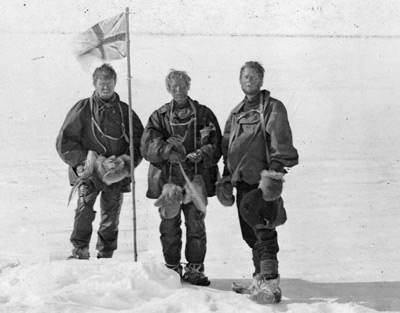This is an account of a little known journey made by three expeditioners in Antarctica over 100 years ago at a time before reliable motor transport, radio or aircraft and with clothing made only of traditional materials such as wool, cotton, leather, and fur.
The intention is to give an insight into the conditions on the expedition and also consider the motivation of the three men who completed it. It can be a starting point for creative writing, art work or performance works using the account and pictures as stimulus material
The main webpage has quotations that are taken from the diary of Prof. Edgeworth David, the leader of the expedition, the PowerPoint presentation has edited versions of these quotes to reduce the word count and simplify the language somewhat so you don't spend so much time explaining what the words mean. If teacher or students want to go into more detail the original text can be found on Project Gutenberg.
Rather than suggest what tasks to set, here's a few possible points of focus:
- Descriptions of the high
and low points.
- 24 hour daylight, travel at any time of day, though constant risk of snow blindness, the sun doesn't need to be shining to get snow blindness.
- Sledding using the sail, being carried along by the wind while riding on the sled.
- The joy of extra food from killing a seal or penguin, especially when on half rations.
- Constant battle against cold and ice, frost on sleeping bag, socks and boots frozen before putting them on when body heat would finally thaw them.
- Reaching the Magnetic South Pole after a long and arduous journey followed by being able to return to the ship.
- Blizzards which confine the party to their tent, boredom and worry at consuming supplies without making progress.
- Motivation, self sacrifice,
duty, reputation, potential glory and reward.
-
Shackleton's letter to Prof. David instructed the 3
man sledge party to try to reach the Magnetic South
Pole. On the 1st of November they took a decision to
travel for 100 miles on half rations to make sure they
could do this, the dangers were sufficient that they
all wrote final messages to their nearest and dearest
in case they didn't return alive.
- Physical risk and discomfort.
-
Oct 17th - snow blindness.
Nov 1st - going on half rations for 100 miles.
Dec 14th - socks freezing solid overnight.
Jan 28th - frost bite.
Jan 30th - chipping boots out from solid ice.
Feb 3rd - falling down a crevasse.
Glossary
Blizzard - A cold storm with winds of at least 56 kilometres per hour (35 miles per hour) and temperatures below - 6.7°C (20°F). Usually also characterized by poor visibility due to snow blowing around. Little snow may actually fall during a blizzard, the high winds pick up snow from the ground and carry it around, visibility is often greatly reduced and travel often impossible.
Crevasse - A deep, usually vertical, crack or split in a glacier, occurs as a result of the brittle ice flowing over a uneven surface beneath the ice. Crevasses can easily become covered by blown snow, even very wide ones. Great care must be taken when crossing ice and snow fields to avoid them as falling down one is going to hurt a lot or be fatal.
Depot - Food and fuel taken and left at marked places along a route before the main expedition takes place, to be used by the expedition allowing them to travel more lightly and travel further. Each depot requires a journey out from the expedition base and back.
Frost bite - Cold damage causing the death of body cells starting at the extremities, if mild it affects the skin only and is painful but recoverable. More seriously it can result in the loss of fingers, toes, ears etc. even parts of limbs.
Glacier - A river of ice. Usually a mixture of ice, air, water, and rock debris formed at least partially on land. They are large enough for the ice to flow with gravity. Glaciers can be small valley glaciers, ice streams, ice caps, and ice sheets. The term glacier also includes ice shelves if they are fed by glaciers. Made of freshwater ice.
Glacier tongue - Sometimes glaciers meet the sea and keep on going, like toothpaste being squeezed out of a tube, this is a glacier tongue, they can be 10 miles or more wide and several times longer than this.
Hoosh - A simple stew made of sledging biscuits, pemmican (a block of dried meat and fat) and water (from snow), mixed and heated using minimal fuel (no actual cooking required). It was the staple diet of field parties in Antarctica at this time.
Man haul - Pulling a sled by use of a harness by people instead of dogs or mechanical means. Considered by some early Antarctic explorers as being purer or more "honest" than any other means.
Snow blindness - A painful condition caused by the reflection of uv light from snow and ice causing sunburn of the front layers of the eye, the conjunctiva and cornea. This can happen even in overcast conditions if some kind of lens is not worn to reduce the brightness of the light. The treatment is to avoid exposure to bright light until the eye has healed naturally.

